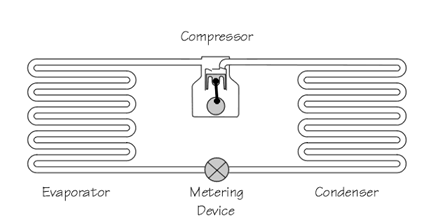 |
||||||||||||||
| Home | Products | Solutions | Locations | Resources | ||||||||||||||
| Resources > Refrigeration Basics | ||||||||||||||
|
The Main Components
There are 4 main components in a mechanical refrigeration system. Any components beyond these basic 4 are called accessories. The compressor is a vapour compression pump which uses pistons or some other method to compress the refrigerant gas and send it on it's way to the condenser. The condenser is a heat exchanger which removes heat from the hot compressed gas and allows it to condense into a liquid. The liquid refrigerant is then routed to the metering device. This device restricts the flow by forcing the refrigerant to go through a small hole which causes a pressure drop. The component where the evaporation takes place is called the evaporator. The refrigerant vapor is then routed back to the compressor to complete the cycle. The refrigerant is used over and over again absorbing heat from one area and relocating it to another.
Metering Device There are several types but all perform the same general function which is to cause a pressure drop. There should be a full column of high pressure liquid refrigerant (in the liquid line) supplying the inlet of the metering device. When it is forced to go through a small orifice it loses a lot of the pressure it had on the upstream side of the device. The device has this name because it meters the flow of refrigerant into the evaporator.
The Evaporator The evaporator could be the forced air type and could be constructed of many copper tubes which conduct heat well. To further enhance heat transfer the pipes could have aluminium fins pressed onto them. This vastly increases the surface area that is exposed to the air. And this type of evaporator could have a fan motor sucking air through the fins. The evaporator would be capable of reducing the temperature of air passing through the fins and this is a prime example of the refrigeration effect. If that evaporator was located in a walk in cooler, the air would be blown out into the box and would pick up heat from the product; let's say it is a room full of eggs. The flow of heat would be egg core/egg shell/circulating air/aluminium fins/aluminum evaporator pipe/liquid droplet of refrigerant. The droplet of refrigerant has the capability of absorbing a large quantity of heat because it is under conditions where it is just about ready to change state into a gas. We have lowered it's pressure, we have increased surface areas and now we are adding heat to it. Just like water, refrigerants also have ratings for Latent Heats of vapourization in BTU's per LB. When heat is picked up from the air stream, the air is by definition cooled and is blown back out into the box to take another pass over the eggs and pick up more heat. This process continues until the eggs are cooled to the desired temperature and then the refrigeration system shuts off and rests. But what about our droplet of refrigerant. By now it might have picked up so much heat that it just couldn't stand it anymore and it has evaporated into a gas. It has served it's purpose and is subjected to a suction coming from the outlet pipe of the evaporator. This pipe is conveniently called the suction line. Our little quantity of gas joins lots of other former droplets and they all continue on their merry way to their next destination.
The Compressor The compressor performs 2 functions. It compresses the gas (which now contains heat from the eggs) and it moves the refrigerant around the loop so it can perform it's function over and over again. We want to compress it because that is the first step in forcing the gas to go back into a liquid form. This compression process unfortunately adds some more heat to the gas but at least this process is also conveniently named; The Heat of Compression. A popular type of compressor is the reciprocating compressor. On the down stroke refrigerant vapour is drawn into the cylinder. On the upstroke those vapours are compressed. There are thin valves that act like check valves and keep the vapours from going back where they came from. They open and close in response to the refrigerant pressures being exerted on them by the action of the piston. The hot compressed gas is discharged out the...you guessed it; discharge line. It continues towards the last main component.
The Condensor The condenser is similar in appearance to the evaporator. It utilizes the principles to effect heat transfer as the evaporator does. However, this time the purpose is to reject heat so that the refrigerant gas can condense back into a liquid in preparation for a return trip to the evaporator. If the hot compressed gas was at 135 ºF and the air being sucked through the condenser fins was at 90 ºF, heat will flow downhill like a ball wants to roll down an inclined plane and be rejected into the air stream. Heat will have been removed from one place and relocated to another as the definition of refrigeration describes. As long as the compressor is running it will impose a force on the refrigerant to continue circulating around the loop and continue removing heat from one location and rejecting it into another area.
|
|||||||||||||
| ABOUT RCC | CONTACT US | PRIVACY STATEMENT | SITE MAP |
© Refrigeration Components Canada 2012 . |

